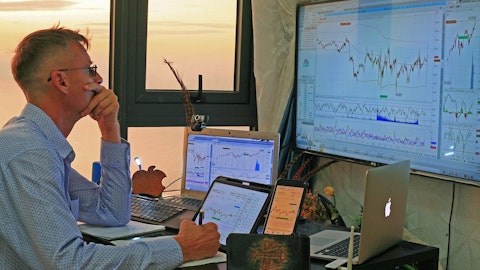And there’s no — we have 98 markets out of Minneapolis. Five of them are year round. And so, just — the Minneapolis consumer wants to go very different places at different times based on the calendar, and we’re designed to do that. So I’m not too concerned about it. I think we’ll continue to have some overlap, particularly in the kind of traditionally largest leisure markets like Cancun, Orlando and Vegas, for example, and then probably also Detroit and Denver because those two carriers serve those markets a lot. But I don’t think that changes my outlook at all. Grant, anything to add?
Grant Whitney: The other thing I would add to that is we’ve added a lot of service to a lot of new markets. So we’ve added new markets that allow customers here, notably leisure customers, to go non-stop. The other thing that I think is a really important component of this, Mike, is that Minneapolis has high point of sale coming out of the market. So all that has been done by this team to build the brand, build our seat share is really powerful because as people go and look for places to go, they really come to — they’ll go to delta.com, but they’ll also kind of suncountry.com. So for others to come into the marketplace, it isn’t just as easy as saying, “Hey, I’m going to put planes up here, and they’re going to be successful.” There’s a lot of work to get us into what we built and developed over the last few years.
Jude Bricker: And I can’t overstate the volatility of our schedule. We’ll have days with 150 flights and days with three in the third quarter. And it’s just — that’s how we’re able to generate these unit revenues reliably.
Michael Linenberg: Yeah. Great. And just if I could squeeze in one quick last one, Jude. If you had the right amount of pilot time so that you could really lean in during the peaks during the September quarter, how much better — like how much margin have you left on the table because you’re not at the optimal staffing level just yet, knowing that, that additional flying tends to be very high margin? Just trying to…
Jude Bricker: So, our variable contribution in July is about 40%. And that’s — so incremental flying into that period would be a little bit lower than that because when we’re capacity constrained on monthly block hours, we’ll bunch together the flights on the peakiest of days. So, we’d be expanding into Wednesdays and Saturdays, for example, but it’d still be in the 30%, 25% range. And that demand period would have lasted into the beginning of August. So that 3,500 of foregone block hours probably would produce somewhere in the range of $7 million to $10 million of operating earnings for the quarter.
Michael Linenberg: Okay. Very good. Thank you. Thanks everyone for answering my questions.
Jude Bricker: Thanks, Mike.
Operator: Thank you. Please standby for our next question. Our next question comes from the line of Scott Group of Wolfe. Your line is now open.
Scott Group: Hey, thanks. Afternoon. I know we talked about the fourth quarter RASM assumptions, but maybe just help us with some of the other pieces in the fourth quarter revenue guide, scheduled service capacity and then maybe expectations on charter and cargo revenue.
Jude Bricker: I’ll start with the easy one. Cargo is fairly flat, which we would expect every quarter to be from kind of looking forward. Dave, anything else?
Dave Davis: Yeah. I mean, we talked about what our sort of — what our revenue growth and our block hour growth expectations are for the fourth quarter. I think we’re probably going to see unit revenues down moderately in the fourth quarter, and we’ve got largely these maintenance costs as the biggest driver of CASM in Q4. I think those are sort of the major trends.
Scott Group: Okay. And then maybe — I get there’s a lot of seasonality to your model each quarter, and there’s just not a lot of pre-pandemic history. Just so what I’m hoping to get some help on here is, right, if you just look at the operating margins, Q1 was 20%, Q2 was 15%, Q3, 8%, now this quarter is 4%. I mean, what’s your — like what’s the margin run rate do you think we’re at right now entering 2024? Is this based on what you know today? Is this a mid single digit margin, a high single-digit margin, a double-digit margin? I just — it’s hard to know, right? There’s so much seasonality. We just don’t have a lot of history.
Jude Bricker: Our pre-tax trailing 12-month margin is 10.2%. And so you were talking about operating margins, so that put operating margin probably in the 14% range. I mean, I think that’s something we should be able to continually replicate.
Dave Davis: I think that 14% number is replicatable in the near future, and the potential for the business is greater than that. I mean, Jude mentioned the number. Once we get sort of the full advantage of the peak opportunities, particularly in the summer months, we should be able to do better than that sort of mid-teens operating margin number.
Scott Group: And you feel like you’ve got visibility to that low-teens op margin next year?
Jude Bricker: Yeah. I mean, we’re selling through Labor Day. So we have pretty good visibility into sales. I don’t know if you watch our schedule that much, but we’re adding January. Other commentary you’re seeing around the industry is people cutting back in January as being a trough period. We’re seeing the need for more capacity and also responding to improved pilot staffing situation. Yeah, I think it looks kind of pretty good in the first quarter.
Dave Davis: Yeah. So I mean, we’re not giving full-year 2024 guidance at this point. But based on where we’re at now in terms of getting our plan together for next year, we think we have some very achievable revenue and cost goals, and they put our op margin in that range that we were just talking about.
Scott Group: Okay. And then maybe just lastly, just some of the puts and takes around free cash flow for next year. It sounds like CapEx coming down a bunch. But how do you think about free cash flow next year?
Dave Davis: Yeah. So free cash flow is going to be significantly higher. First of all, again, not to give too much ’24 guidance, but we expect a material improvement in results next year and a drastic reduction in CapEx. So I think we’re going to be a very strong free cash flow generator, which is one of the reasons we felt comfortable allocating another $25 million to share repurchases. We will continue on this track. Our aircraft are largely purchased. Operating results look strong. Based on what we’ve seen so far, we’ll continue to make the best use of our cash as we generate it.
Scott Group: Okay. Thank you for the time guys. Appreciate it.
Jude Bricker: Thanks, Scott.
Operator: Thank you. At this time, this does conclude our question-and-answer session. I would now like to turn the call back over to Jude Bricker for closing remarks.
Jude Bricker: Thanks for your time and attention, everybody. We’ll talk to you again at the end of the year. Thanks.
Operator: Thank you. This does conclude today’s conference. You may now disconnect.
Follow Sun Country Airlines Holdings Inc. (NASDAQ:SNCY)
Follow Sun Country Airlines Holdings Inc. (NASDAQ:SNCY)
Receive real-time insider trading and news alerts


